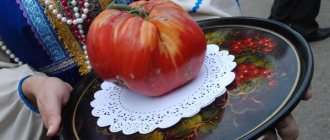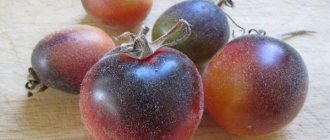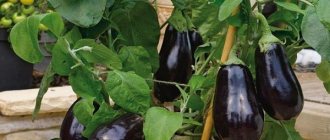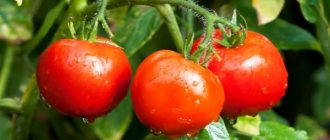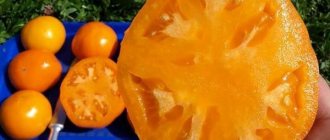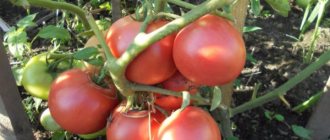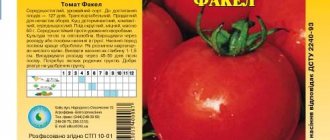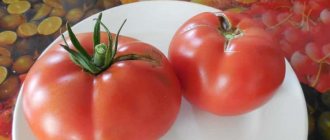An unusual name for a tomato is Hairy Bumblebee. It's all about the velvety skin and neat oval fruits. The interesting variety was liked by many and was included in the State Register.
| Height | Landing location | Ripening time | Fruit color | Fruit size | Origin | Fruit shape |
| short | Greenhouse, Open ground | Mid-early | Reds | Average | Variety | Plum-shaped or oval |
Description of the tomato variety Shaggy Bumblebee with photo
The cultivar was bred by breeders of the Seeds of Altai agroconcern and included in the State Register. Refers to standard determinant varieties. Such bushes reach a certain point, then stop growing on their own. Plant parameters:
- The shoots are no more than 50-60 cm high. The stems are strong and compact. The bush is not spreading, it holds its shape well.
- The leaves are dark green, with a small, showy edge. They have a slightly bluish tint. The plate size is average.
- The inflorescences are simple, the variety forms clusters of 5-7 tomatoes.
A standard bush does not require a lot of space and painstaking care. With proper planting arrangement, you can save garden space and get a good harvest. The photo will complement the description of the Shaggy Bumblebee tomato variety:
Fluffy bushes can be used to compact plantings of other varieties.
Description of fruits
For the Shaggy Bumblebee tomatoes, vegetable growers have chosen the most sonorous definition - exotic. The reason is very simple. The tomato skin is covered with pubescence, like a peach, which fully justifies the name of the variety.
The remaining parameters of tomato fruits are also attractive:
- The shape is plum-shaped, there is a small spout at the tip of the tomato.
- The weight of a large tomato is about 135 g. Most often, the weight of tomatoes does not exceed 100 g.
- The color of ripe fruits is bright red-orange, while unripe ones have a green tint.
- The tomato skin is strong and smooth, very resistant to cracking.
- The pulp is moderately juicy, but meaty. On a horizontal section, 3-4 seed chambers are visible. Not many seeds.
- The taste is pleasant sweet with a slight sourness. At first, it doesn’t differ at all from the classic tomato taste. Then, according to reviews from vegetable growers, it acquires the taste of tropical fruits.
Vegetable growers give the fruits of the Shaggy Bumblebee variety high marks. Not only for its appearance and taste, but also for its ability to be transported and keeping quality.
The fruits can be used to decorate dishes
Description of the plant
This new variety was included in the State Register of Russia; it is grown both in open ground and in greenhouses of private farms. Bred by Agro breeders.
The tomato bush Shaggy bumblebee is a medium-early ripening crop. This variety is determinate; it grows in the form of a trunk. The height of the plant reaches up to 60 cm.
The timing of obtaining earlier fruits is regulated by pinching to the lower flower-fruit cluster. The plant has fluffy, medium-sized leaves, dark green in color and a simple inflorescence.
Characteristics of the tomato Shaggy bumblebee
The tomato variety is intended for cultivation in protected ground and open ground. Excellent taste and presentation, the ability to withstand long-term transportation without damage, the ability to store crops for a long time, resistance to crop diseases and temperature changes are its main characteristics. The plant does not require formation. The listed features make growing the Shaggy Bumblebee variety a very effective undertaking for any site.
Tomato yield Hairy bumblebee and fruiting
The harvest ripening period is mid-early. The fruits are removed from the bush 95-105 days after emergence. Vegetable growers slightly speed up the ripening period of tomatoes by regulating pinching due to the fruiting clusters of the lower row. Subject to the rules of agricultural technology, varieties from 1 sq. m of greenhouse area, up to 9 kg of ripe fruits are collected. In open ground, the yield indicator is 5-7 kg per 1 sq. m. When transferred to a bush, you can get 2-3 kg of exotic tomatoes from one plant.
Area of application of fruits
The excellent taste and unusual shape of the Shaggy Bumblebee variety allow cooks to experiment. Tomatoes are used fresh for preparing first and second courses. Whole-fruit canned Shaggy Bumblebee tomatoes look very original. At the same time, it is equally good if you close one variety of tomato or combine it with others. In addition, the juiciness of the pulp allows you to prepare excellent-tasting juices, sauces, and ketchups.
Resistance to diseases and pests
Tomato varieties have good immunity. If the growing rules are followed, they are not affected by fungal infections. Biological pests may appear on plants, especially if crop rotation requirements are not observed.
HAIRY BUMBLEBEE, 10 pcs.
Delivery methods and pickup:
Delivery throughout Novosibirsk and Novosibirsk region (Delivery is carried out 7 days a week)
— weekdays from 18-00 to 21-00 — weekends and holidays by agreement from 7-00 to 17-00
— Pickup from the warehouse — Novosibirsk, Gusinobrodskoe highway 33/2 B, 2nd floor, Region market, opening hours Tue-Sun from 8-00 to 16-00
The minimum amount for order delivery is RUB 3,000. Less than 3000 rubles - individually.
We can also always meet you at the Zolotaya Niva or Berezovaya Roshcha metro stations and hand over the goods personally.
Transfer of goods through RCR
The order is sent to the Distribution Centers after making 100% payment for the order - transferring funds to the Sberbank card.
Distribution centers for residents of Novosibirsk, Novosibirsk region and Berdsk
RCR Lenin Square: Krasny Prospekt, 28.
RCR Kalinin: Krasny Prospekt, 182. RCR Novosibirsk Main: Vokzalnaya Magistral, 3/1. RCR KALININ. m. Zaeltsovskaya, pl. Kalinina, Krasny Prospekt 182, shopping center "Europe", RCR Dobry (River Station): Zyryanovskaya st. 34/1. RCR Rechnoy: st. Bolshevikskaya, 12. RCR Equator: Shopping center Center Rechnoy, Bolshevikskaya, 43/1, 3rd floor, pavilion No. 301 RCR Gorsky: st. Gorsky mn, 74. RCR Western: st. Titova 198. RCR Zatulinka: st. Petukhova, 76. Marx RCR: st. Vatutina, 27/ K. Marx, 1. RCR Telecenter: st. Serafimovicha 24/1 RCC MZHK: st. Vysotskogo 43. RCR NIVA: st. Koshurnikova 45. RCR Teacher's office: Bogdana Khmelnitsky 72, office 206. RCR Felix: Dzerzhinsky Avenue 79, office 20. RCR No. 56 (Snegiri, ): Rassvetnaya 10 RCR st. Kochubeya, 3/1 - 1st floor Transport stop "Springs", Holdy Discounter store LC "Mercury" (Vybornaya-Klyuch-Kamyshenskoye Plateau): st. Vybornaya, 144 (TC “Tetris”) RCR Volna (ObGES): st. Sofiyskaya 1/1 Victoria trading house. RCR Pervomaika: st. Shmidta 8. RCR Akadem: st. Zhemchuzhnaya 34, Pavilion “Pearl”. RCR *SH*: st. Polevaya 16. RCR-O Koltsovo: Koltsovo, Nikolsky Avenue, 6. RCR Yolka (Nizhnyaya Eltsovka): st. Zelenaya Gorka, 1 Institute Gidrotsvetmet, office No. 102. Distribution Center in Berdsk: Berdsk, Ushakov St., 3.
Delivery throughout Russia
Delivery of goods is carried out by the Transport Company or Russian Post, the standard cost of delivery of goods from our warehouse to the Transport Company terminal in Novosibirsk is FREE.
The final cost of the Transport Company’s services depends on the dimensions, weight of the cargo and the area in which the final delivery point is located.
Payment Methods:
— Payment in cash (for pickup)
— Payment by Visa/Mastercard bank card
— Cash payment to our courier upon receipt of the goods (Novosibirsk and Novosibirsk region only)
— Non-cash transfer of funds
Advantages and disadvantages of the variety
Vegetable growers love the Hairy Bumblebee tomatoes for their large list of positive characteristics. This variety is always worth the effort spent on growing it.
With proper care, a small bush gives a good harvest
pros
- Low compact bush size. This makes it easier for vegetable growers of any age and experience to care for it.
- Does not require mandatory stepsoning.
- Tomato does not require watering. This quality is convenient when summer residents are on the site only on weekends.
- Versatility of use and cultivation.
- High taste and commercial qualities.
- Resistance to sudden temperature fluctuations.
- Ability to be stored for a long time and withstand long-distance transportation.
Minuses
- Requirement for fertilizing.
- Mandatory garter with a large number of ovaries.
Growing seedlings
The process of sowing tomatoes begins by preparing the substrate. It should be loose and nutritious. It is optimal when it is made from a mixture of turf and humus soil in equal proportions, and peat is added to make it crumbly. You can also use commercial substrate.
This vegetable crop is sown in containers two months before the planned planting in the ground. To do this, pour soil into a prepared container with drainage holes, moisten it, level it and make 1 cm indentations. The distance between them is up to 4 cm. Then the seed material is laid out and sprinkled.
See also
Characteristics and description of the most delicious varieties of black tomatoesRead
On average, the appearance of Shaggy Bumblebee tomato seedlings is possible in a week. After the appearance of young plants, it is recommended to lower the air temperature in the room and carefully analyze the length of daylight hours. It must be at least 12 hours, and if the lighting is not enough, additional lighting is needed. Pick up tomato seedlings when a pair of true leaves appear on them.
Features of cultivation
Standard tomatoes are grown in seedlings. The best time for sowing seeds is March. Which period of the month is suitable depends on the climate of the region. In the southern regions you can start from the first numbers. In areas with cooler weather - closer to the end.
The seeds need to be prepared first. It is enough to select suitable ones by placing them in a saline solution (1 tablespoon of salt per 1 liter of water). Then treat with a solution of potassium permanganate with the addition of “Kornevin”, “Zircon” or “Agate”.
To speed up germination, seeds can be germinated
Store-bought or home-made soil is suitable. To plant tomato seedlings, you need to mix garden soil, peat, sand and humus in equal parts.
Containers should be chosen in such a size that they fit comfortably on the windowsill.
Be sure to treat the container with a disinfectant solution. The soil can be calcined or watered with a fungicide. Then fill the containers with soil mixture, make grooves 1 cm deep, spread out the seeds of the tomato variety, and lightly sprinkle with soil. Moisten the crops from above using a spray bottle.
Now you need to cover the containers with film or glass to create a greenhouse effect. Before germination, place the container in a warm place (+ 23 °C), monitor the appearance of condensation and remove it in a timely manner.
As soon as the first shoots appear, remove the film and lower the air temperature to + 18 °C.
Important! Seedlings need full lighting.
On cloudy days, seedlings must be illuminated so that they do not stretch out. It is also recommended to rotate the container during the day. This technique prevents the tomatoes from leaning to one side.
Healthy seedlings of the variety will easily tolerate transplantation
When 2-3 true leaves appear on the seedlings of the Shaggy Bumblebee variety, it’s time to plant the seedlings. Containers must have a volume of at least 0.5 liters. After 10 days, feed the plants with complex mineral fertilizer.
Seedlings should be watered strictly at the root with settled water. In this case, you cannot flood the roots. Otherwise, the plants will get sick with blackleg. The need for olive oil is best determined by the condition of the topsoil.
2 weeks before planting in a permanent place, begin to harden tomatoes of the Shaggy Bumblebee variety at a temperature of + 14 °C.
As soon as a stable above-zero temperature is established, you can begin transplanting the seedlings into the ground.
Important! When marking ridges, you should strictly follow the rules of crop rotation to prevent the spread of diseases.
The planting density of the variety is no more than 5 bushes per 1 sq. m.
It is important to maintain planting density
Caring for tomatoes consists of:
- Regular root watering. Standard bushes must be irrigated in the morning or evening, trying to prevent water from getting on the leaves.
- Feeding. The variety requires monthly nutrition. 14 days after transplantation, nitrogen components must be added. The furry bumblebee responds well to feeding with an infusion of bird droppings diluted with water in a ratio of 1:20. At the flowering, fruit set and ripening stages, phosphorus and potassium are needed. Here it is better to use wood ash or ready-made mineral complexes.
- Weeding and loosening. Removing weeds helps to ventilate the bushes and prevents the spread of pathogenic microflora. Loosening is necessary only to the depth of the surface crust.
- Mulching. A layer of organic matter will protect the roots from overheating and retain moisture. By rotating, the mulch enriches the soil with useful substances.
There is no need to form the Shaggy Bumblebee variety. However, standard tomatoes have a root system that is not able to withstand a large harvest. To prevent the plant from being torn out of the ground, the shoots should be tied to supports.
Landing
Growing exotic fruits is not as difficult as it might seem at first glance. They are extremely unpretentious, do not require much attention, but at the same time produce a good harvest. Sowing of seeds is carried out in the spring, in March. Pre-prepare suitable soil.
Growing seedlings
To sow seeds for seedlings, nutrient soil with a loose structure is used. It is advisable to improve its quality by adding humus and turf soil in equal quantities, and for lightness - peat and sand.
Sowing is carried out 55 - 60 days before the planned planting of seedlings in the ground. Containers must have drainage holes. Sowing is carried out as follows:
- the prepared soil mixture is poured into the container;
- moisten the ground and slightly level it;
- small holes 1 cm deep are made at a distance of 4 cm from each other;
- seeds are placed in the holes;
- the spread seed material is sprinkled on top with a 1 cm layer of soil;
- the soil is lightly compacted;
- the containers are covered with film and placed in a warm room with an air temperature of +25-26°C.
The first shoots should appear in about 1 week. After this, it is necessary to move the seedlings to a cooler room and provide them with at least 12 hours of daylight. If there is a lack of light, additional lighting must be created.
When 2–3 true leaves appear on the seedlings, tomato seedlings are planted in 500 ml pots. During this period, it is important to monitor the air humidity in the room. It is advisable to irrigate the sprouts using a spray bottle.
Recommendation: to speed up the germination of Shaggy Bumblebee tomato seeds, you can use biostimulants for growth: Zircon, Agate, Kornevin.
Landing in the ground
About 2 weeks before planting the seedlings in the ground, you need to start hardening them at a temperature of about +14°C, taking them out to a cool loggia, balcony, or terrace. The hardening time gradually increases every day.
After the night frosts stop outside and warm weather sets in, the plants can be planted in the ground. Seedlings are planted at the rate of no more than 5 - 7 pieces per 1 square meter. m. There is no need to garter or form bushes. The further growth and development of tomatoes depends on proper care for them.
Pest and disease control
To prevent the appearance of fungal or viral infections on tomato beds, it is necessary to comply with the requirements of agricultural technology:
- follow crop rotation recommendations;
- plant bushes with the required density;
- remove lower leaves;
- follow the watering and fertilizing schedule;
- It is imperative to carry out preventive treatments against nightshade diseases.
Biological pests can also visit tomato beds. You will need to regularly inspect the plants and treat them with preventative agents. When parasites appear, use folk compositions or solutions of insecticides to destroy them.
How to grow Basque blue tomato
You need to sow seeds 65 or 70 days before the plants are supposed to be planted in a permanent place (usually from late February to mid-March). The exact date is determined based on the weather factors of a particular region and growing conditions. Seeds, soil and containers are prepared in advance. The grains need to be sorted, pickled and soaked in a nutrient mixture. Soil taken from a vegetable garden or garden should be disinfected in any convenient way.
Seedlings are grown according to the same rules as for any other varieties. Gardeners often shorten the roots of tomato seedlings when picking; it is not advisable to carry out such a procedure with a Basque blue tomato. Hardening off seedlings for this variety is mandatory.
Planting and care
No more than 4 seedlings are placed on one square meter; they are formed into 3 or 4 trunks. Trellis or stakes are installed in advance; the bush needs to be tied up as it grows. The place where the Basque Blue tomato will grow should be open and preferably windless; even a slight shadow will have a negative effect.
When removing stepchildren, small stumps should be left. The leaves at the bottom of the bush are cut off; the crown does not need to be thinned. There is no special need for hilling, but all weeds need to be removed in time before they attract pests. The soil is loosened from time to time. Watering is carried out 1 or 2 times a week. During particularly hot periods, the ground should be covered with a good layer of mulch and the bushes should be given more moisture.
Feed the Basque Blue tomato regularly (every 15–20 days), organic matter and mineral complexes are suitable. You should be careful with nitrogen fertilizers; it is better to use them only when absolutely necessary.
Basque blue is an excellent variety; planting and growing will not cause any trouble. The care is standard; even a beginner in gardening can easily handle this tomato. Immunity to disease is maintained even when planted in conditions unfavorable for tomatoes.
Harvesting
Almost all fruits will have time to ripen within 90 - 100 days. Like regular tomatoes, fluffy tomatoes do not all ripen at once.
The fruits should be picked when they turn red or pink (depending on the variety). To the touch at this moment they are hard, elastic, but not soft. Juicy and meaty inside. The cells must be filled.
Green tomatoes remain on the bunch to ripen. If they didn’t have time to ripen in time, and it’s cold outside, they can be put in a box and left to ripen at home. According to the description of the Fluffy tomato, the shelf life of the fruit is about a month. Due to their elasticity they are highly transportable.
The description of the Fluffy tomato says that it is a hybrid. The variety is notable for the fact that there is fluff on the fruits, leaves and stems, which gives the tomatoes a velvety feel. The culture has two varieties: Fluffy Red and Pink tomatoes. The yield is high, up to 20 kg per square meter. Tomatoes are not picky about care and are resistant to diseases and weather variability. The main thing is to control the quality and quantity of fertilizing.
Ghost
Mid-season variety for growing in greenhouses. He was bred by Bulgarian breeders. The advantages of “Ghost” are high productivity, good immunity to diseases and pests.
The bushes are tall, up to 2.5 meters in length. They need to be tied up. The fruits are small - 50-100 grams, orange-yellow, with white streaks. Texture The skin is smooth, round in shape. The flesh is fleshy, with a lot of sweetness and juice.
The fruits of this variety are well preserved.
